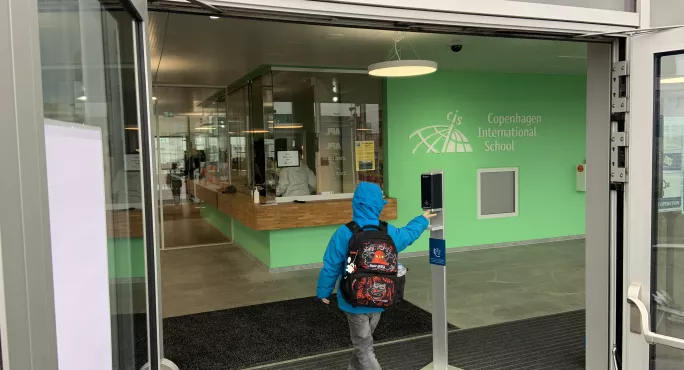- Home
- 10 ways a Danish school made social distancing work
10 ways a Danish school made social distancing work

Talk of reopening a school is one thing, but there are clearly going to be lots of practical considerations that need to be put into place to provide a safe, socially-distanced school environment for both staff and pupils.
Copenhagen International School has been through exactly that after it returned to school over two weeks ago, with nearly 400 early years and primary school students returned to campus in that time.
We spoke with the facilities manager at the school, Kent Sehested, to find out some of the processes that have been put in place to ensure social distancing.
1. Clear signs and clear directions
Firstly, it is important to make sure all the new measures are clearly laid out to parents and staff so they know how the new school day will work.
“It’s been a big help that our school director sent out an email with clear instructions to parents a few days before we reopened,” Sehested says.
He explains that this meant most parents and pupils were well prepared and knew what to do from the first day.
Furthermore, when parents and children do arrive, he and other school staff make themselves visible to help with any questions
”My colleagues and I are outside every morning wearing traffic vests, helping people get into the right queues. We answer their questions and we are there - it makes everybody feel secure.”
2. Physical distancing starts outside
Arriving at school is possibly one of the biggest potential contact risk areas, so placing measures outside that help people maintain distance is crucial.
“We have put up traffic control bollards to help our community form a queue with two metres between them. That really helps ensure physical distancing.”
This has been done using sports cones, so many other schools may have something similar they could use.
3. Physical distancing continues inside
This continues inside, too: “We’ve put masking tape on the floor to help children keep their distance. It’s much easier for them if they can see where they should be,” Sehested explains.
4. Staggering attendance times
To avoid having a ‘rush hour’, students arrive and leave at different times. Half of them arrive at 8.30 and the other half at 9, and in the afternoon, they leave at 2.30 and 3.
This can mean that public transport services are not feasible owing to both timings and being too crowded.
“We have also had to cancel our school bus service because we couldn’t maximise distancing and minimize the number of children in one place,” Sehested adds.
5. Minimizing and directing traffic
Another key consideration is to ensure there are well-managed entry and exit points, to avoid the risk of people coming and going without adhering to the rules or creating areas that are too busy.
“Instead of using the front door, we use three separate entrances and three separate exits to make sure we don’t create bottlenecks,” Sehested says.
“And we make sure people are moving in one direction around the building, counter-clockwise, so it’s a one-way flow and they don’t bump into each other or cause traffic jams.”
6. Waiting lounges and sanitizers
Ensuring cleanliness is vital, which is why the school has created a ‘holding zone’ where students must ensure they have sanitized before going elsewhere in the school.
“Once students enter the building, they’re seated in waiting lounges with appropriate spacing between chairs. We have sanitizers at every entrance and exit to make sure everyone who enters or leaves the building is as clean as can be.”
7. Homeroom teaching with groups of ten
Small classes with set teachers are a simple but effective way of reducing the risk of contamination.
“Our students are taught in groups of ten, and they stay with one teacher in one room and have their own designated bathroom and handwashing facilities. Single-subject teaching is still done remotely, but in the classroom.
“That way, students get specialised teaching while making sure they only physically meet their nine classmates and one teacher.”
8. Individual lunch boxes brought to the classroom
Lunch is another area where reducing contact can be easily tackled - by taking lunch in the same classroom.
“Instead of taking food from a buffet and eating in our cafeteria, food is served in individually packaged lunch boxes that are brought to the classrooms,” says Sehested.
The school says these lunchboxes are disposable, which goes against its ethos as a sustainable organisation, but that at present it is the only solution they have to ensure children are safe.
9. Frequent cleaning. Very frequent.
As you would imagine, everything is cleaned regularly.
“Bathrooms, handrails, toys and other things that are frequently used are cleaned twice a day,” says Sehested.
This cleaning is done by the school’s usual cleaning staff but because everything is being cleaned more often the school acknowledges it is increasing costs, although because other parts of the school are not currently open, that is saving some money, too.
10. Be flexible
“To sum it up, I think it’s all about being flexible, listening well and making changes fast if necessary,” says Sehested.
“It’s been a lot of work,” he reflects, “but we are open, and it’s great to have the students here. Day by day, we are returning to normality.”
Keep reading for just £1 per month
You've reached your limit of free articles this month. Subscribe for £1 per month for three months and get:
- Unlimited access to all Tes magazine content
- Exclusive subscriber-only stories
- Award-winning email newsletters



